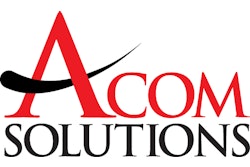Component manufacturer finds value in pairing solutions to handle labor reporting complexities
Miami Lakes, FL — December 5, 2003 — Aircraft Braking Systems Corp. (ABSC), a manufacturer of wheels, brakes, brake control and related systems for the commercial, military and general aviation markets, said it is using Kaba Benzing's AutoTime time and attendance and labor reporting software in conjunction with SAP R/3 to realize increased productivity and decreased payroll costs.
ABSC said it began looking at its corporate information system in the early 1990s. The Akron, Ohio-based company decided to navigate a new course for accurately documenting time, attendance and labor collection on the job.
"We needed to track time and labor against multiple jobs where pay rules were exceedingly complex," said Tom Johnson, a senior systems analyst/specialist and project manager for ABSC. "We also needed to integrate that data with payroll and the [materials resource planning] MRP system we were using at the time."
In a relatively short period of time, ABSC said it went from using manual processes and paper time cards that provided inaccurate results, delayed feedback, and zero integration or validation, to the automated environment of Kaba Benzing's AutoTime.
By using a software system for time and attendance, labor distribution and material movement tracking for exempt and non-exempt personnel, ABSC explained that it was able to capture and process direct and indirect labor and calculate employee payroll in environments ranging from simple to complex. AutoTime also accommodates the ever-changing work rules that govern employee pay.
In addition, ABSC said it could create real-time audit trails and collect time, attendance and labor data for its Manufacturing Execution System, as well as automate and control shop floor processes. That means ABSC could enforce payroll and contractual time and attendance rules; properly calculate and allocate labor to orders, activities, and/or accounts; provide real-time functionality for supervision; maintain an electronic time card system; provide historical audit information; and provide real-time management decision support.
For ABSC, that meant less time and money spent on payroll, with fewer mistakes. ABSC said its managers can spot scheduling problems or costly overruns so that they can be corrected before they adversely affect the bottom line. Supervisors at ABSC have the information they need to make cost-cutting decisions every minute of every day. Precise systems simply result in better productivity.
As the company expanded, however, it found that it had outgrown its business systems. ABSC selected SAP R/3 4.0bto replace its mainframe MRP system in 1998 and integrated it with AutoTime.
"When we settled on SAP solutions, the transition was smooth because we were provided with a version of AutoTime that had an SAP-certified interface. At the same time, additional functionality that we needed to support the SAP solutions environment was developed," reported Johnson.
By using SAP and AutoTime together, ABSC said it was able take advantage of many features made available by integrating its business system with its time and attendance solution. The company uses a SUN server and UBI client configuration now. ABSC later upgraded to SAP R/3 4.6 and AutoTime 5.3, which is the system it is using today.
ABSC said it plans to implement additional new AutoTime 5.3 functionalities, including salary time cards, overtime scheduling, and rotating schedules/batch data collection. New ADC client hardware will also allow the company to implement additional functionality such as an improved maintenance system. Finally, AutoTime 5.3 will ease support and integration for future ABSC initiatives such as an upgraded GEAC payroll system and full implementation of Rockwell's APS scheduling application (RSBizWare Scheduler).










